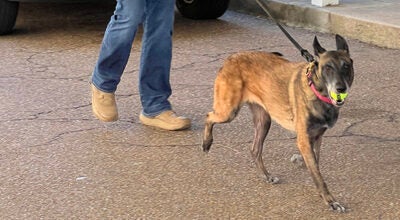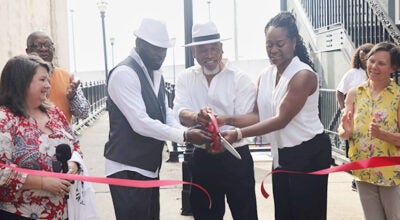ERDC engineers speak to VHS STEM students
Published 10:07 am Wednesday, March 18, 2015

Cary Talbot talks to STEM students at Vicksburg High School while slides on the importance of engineering careers are shown. Talbot is associate technical director of the coastal and hydraulics lab at the U.S. Army Corps of Engineers Research and Development Center. (Danny Barrett Jr. / The Vicksburg Post)
Do you know where the City of Vicksburg gets its water to drink, shower and bathe in?
Three ninth grade science and math classes at Vicksburg High School know the answer now — thanks to engineering and a day of programs at the school put on by experts at the U.S. Army Corps of Engineers Research and Development Center.
“It essentially comes from the Mississippi River, but very indirectly,” Cary Talbot, an associate technical director at ERDC’s coastal and hydraulics lab, told students Tuesday. “You’ll see some tall cylinders up at the port sticking up 20 or 30 feet in the air that the city uses to pump groundwater out from underneath the Mississippi River. It’s filtered many, many layers from hundreds of feet of soil. But you have to have engineering to figure that all out.”
Talbot’s presentation on engineering careers was done in association with the Vicksburg Warren School District science fair. In all, six experts from ERDC and the Corps’ Vicksburg District spoke to STEM students, ninth grade STEM teacher Deborah Brown said. The group included students in Cassandra Farish’s and Hazel Robinson’s STEM classes.
“This is where the job corps will be coming out of,” Brown said. “And we touch on it with this, with robotics, with engineering design and all. This gives them a more vivid imagination of how the workforce is going within the STEM field.”
Engineering’s small contributions to daily life, from showering with clean water to enjoying a structurally stable building to house school, were part of Talbot’s slideshow, as were engineering’s lessons through the years. Those lessons included examples in resonant frequency, as with the first Tacoma Narrows Bridge, in Washington state, and in building stronger flood protection structures, as seen in an interactive version of the inundation of New Orleans during Hurricane Katrina.
“When it rains, water runs from high ground to low ground,” Talbot said. “When the levees broke, the levees were at the lowest parts of the city. So, this is why you had a reverse of water. In the morning, it was because of the rain going from high areas to low areas. Then, when the levees broke, it was going from the low areas to the high areas.”
Opportunities for landing high-paying jobs, a key thrust of the schools’ and the Corps’ participation in promoting math and science was a message present in Tuesday’s programs.
Talbot’s presentation compared engineering with being an athlete, being in business and being a lawyer. It ranked lower in pay than an athlete, but higher for effect on the world than business.
“Thankfully, engineering is a really nice challenge,” Talbot said, adding there’s an importance to building things and solving problems. “It’s very well-paid and a lot of satisfaction in doing it.”





